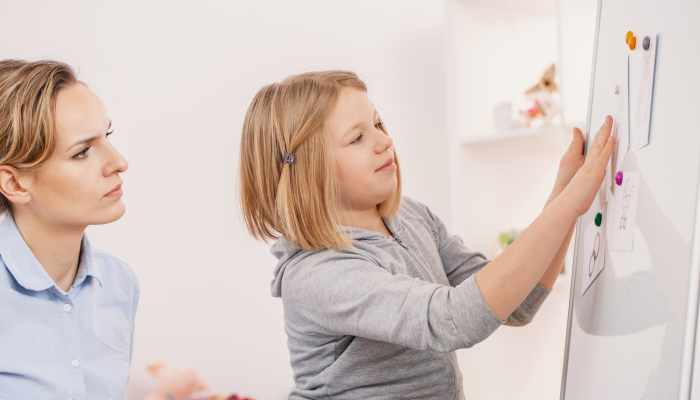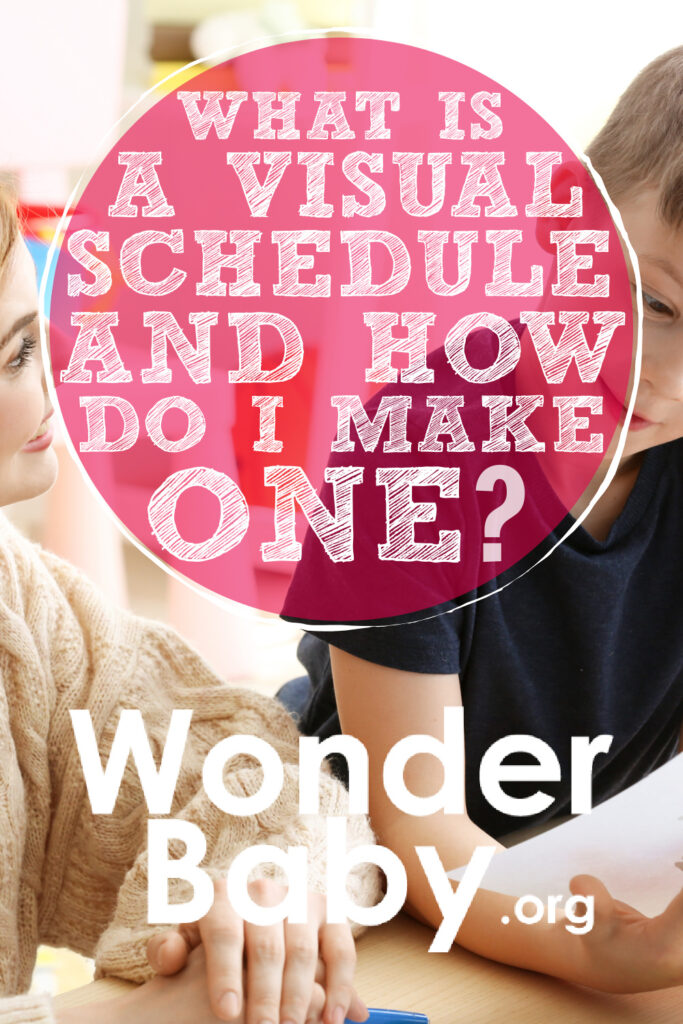What Is a Visual Schedule and How Do I Make One?

- A visual schedule is a tool that uses pictures, symbols, words, or a combination of all these things to visually remind the user of steps in a task, activities in a routine, or events in a daily schedule.
- Visual schedules can help kids manage their emotions, stress, and expectations in their everyday lives.
- This is a helpful technique to use for kids with autism, ADHD, or communication, speech, or language disorders or delays.
- For maximum benefit, a visual schedule should be tailored to the individual’s needs, specific challenges, and family routines.
- Visual schedules can take many different forms and you should customize them to suit your child’s ability and communication skills.
Using a visual schedule can help encourage your child’s independence, reduce your daily family stress around activities and routines, and provide a sense of predictability and calm for your kids—particularly if they have autism, ADHD, or communication challenges.
For children who are easily overwhelmed by multi-step tasks, who have difficulty with transition between parts of their day or individual activities, or who struggle to remember daily routines, visual schedules provide support that they can access independently.
If you’ve thought about creating a visual schedule for your child but you’re not sure where to begin, read on for more insight on what a visual schedule is and how you can make one.
What Is a Visual Schedule?

A visual schedule11. Patel, S.. 10 Tips for Creating a Visual Schedule for Your Child. NAPA. 2024. https://napacenter.org/visual-schedule, sometimes referred to as a visual activity schedule, is a learning tool that breaks down tasks and activities into simple pictures, symbols, or words, usually placed in order on a board, chart, or poster. They are easy for children to understand and refer to and help them remember routines or multiple steps in a task.
A visual schedule is helpful for children with autism spectrum disorder (ASD)22. Knight, V., Sartini, E., & Spriggs, A. D.. Evaluating visual activity schedules as evidence-based practice for individuals with autism spectrum disorders. Journal of Autism and Developmental Disorders. 2015;45(1), 157–178. https://doi.org/10.1007/s10803-014-2201-z, attention deficit hyperactivity disorder (ADHD)33. Thomas, N., & Karuppali, S.. The Efficacy of Visual Activity Schedule Intervention in Reducing Problem Behaviors in Children With Attention-Deficit/Hyperactivity Disorder Between the Age of 5 and 12 Years: A Systematic Review. Journal of the Korean Academy of Child and Adolescent Psychiatry. 2022;33(1), 2–15. https://doi.org/10.5765/jkacap.210021, and other communication, speech, or language disabilities or delays44. How visual timetables can support children with speech, language and communication needs in the early years. EYSEND. https://councilfordisabledchildren.org.uk/sites/default/files/uploads/attachments/Visual%20Timetables%20Resource.I%20CAN.FINAL_.pdf. Simple visual schedules can also be useful for very young children of all abilities.
Parents and teachers use visual schedules to map out activities for a day or part of the day, a daily routine, a multi-step task, or, for older children, even a week of activities.
A visual schedule gives children a clear reference point for what to expect in their home or school setting at a particular time of day. It also clarifies what is expected of them during those activities.
Visual schedules aid children with transitions between activities, support their independence, and increase their understanding, self-awareness, and time management.
There are many ways to use a visual schedule, according to Autism Parenting Magazine55. Burby, L.. Benefits and Uses of a Visual Schedule for Children with Autism. Autism Parenting Magazine. 2023. https://www.autismparentingmagazine.com/effectiveness-visual-schedules. It can be used to:
- Create a daily or weekly schedule.
- Show steps in a task like using the toilet in potty training or getting ready for bed.
- Make a to-do list.
- Aid in communication for semi-verbal or non-verbal children.
- Offer choices of activities to a child.
Benefits of Visual Schedules

Using visual schedules as a learning tool offers many benefits to children, parents, and teachers.
| Enhancing understanding and predictability | When children know what to expect and what activity or task is coming next, their anxiety about change is reduced. Children with autism may feel more secure and emotionally ready when they know what to expect. The schedule reduces the chances of unpredictable events, thus reducing triggers for acting out or other inappropriate behaviors. |
| Supporting transitions between activities | Transitions between activities are often the most challenging for children who rely on routine or who are rigid about the order in which things happen. When children know what to expect they are better able to cope with transition. |
| Improving time management skills | Time can be a difficult concept for a child with special needs to understand. Visual schedules give kids with ADHD a helpful reference point for managing time, staying organized, and remembering what they are supposed to be doing. |
| Strengthening communication abilities | For children who are non-verbal, semi-verbal, or who have verbal delays, a visual schedule can be a useful communication tool. |
| Encouraging independence | A visual schedule which prompts children and young learners to remember the steps in a task or daily routine enables them to complete activities independently. This provides opportunities for increased self-esteem, positive reinforcement, and praise. |
By increasing predictability, security, and independence, a visual schedule can also reduce stress and anxiety for children and parents, making transitions smoother.
Types of Visual Schedules

Visual schedules should be individual to every child, family, or classroom. You can create a visual schedule for:
- A specific task, like getting dressed.
- To remember daily activities for a particular day.
- To institute a new routine, for example, for taking medication.
- To help with an existing routine, like your morning routine or your bedtime routine.
- To create a daily schedule so your child knows what to expect on a school day or what to expect on a Saturday.
- To create a weekly timetable so that your child is aware of what is happening every day.
Examples of Visual Schedules
A visual schedule must be tailored to your needs and the needs of your child. Visual schedules can be as simple as a now and next board, showing what your child is doing now and what they will do next.
This type of schedule keeps them focused, helps them with transition, and helps increase their understanding of what is happening at the moment and what they can expect to happen next.
A picture schedule could also be used for a specific routine or set of daily tasks that your child needs help with, for example, the morning routine. It may have simple pictures reminding your child to brush their teeth, get dressed, put on their shoes, get their backpack, and find their coat.
- Great to help establish a positive morning routine, which is essential to starting the day off right.
- This product provides a visual reminder of tasks that need to be completed in the morning, to allow a sense of calm and organisation
- Both board and symbols are made from plastic so they are incredible durable and hardwearing
- The board measures 31cm x 8cm – a great size to keep it easily portable around the house yet easy to see. The symbols themselves are 4.5cm square, again easy to both see and handle.
A more advanced visual schedule might look like a weekly calendar or a daily schedule with blocks of time. Pictures and words can remind your child of what they need to do and what will happen throughout the day.
Using a visual schedule may be a matter of trial and error at first as you figure out what works best for the particular tasks you’re trying to address with your child.
Regardless of what method you choose, remember that the goal of the visual schedule is to provide clear expectations and ultimately reduce stress and anxiety for you and your child around daily tasks.
How to Create a Visual Schedule

Parents of children with special needs are often advised by teachers, relatives, and friends about tools, activities, and techniques they should use to target their children’s challenges.
It can be overwhelming, especially if that advice has not been asked for. Creating a visual schedule, however, should feel empowering for you and your child.
It’s important to remember that you know your child best. You know their strengths and weaknesses, the areas they need help with, the activities that trigger inappropriate behaviors or anxiety, and the daily routines and tasks that they find challenging.
By tailoring a visual schedule to your child’s needs, both you and your child should feel an increased sense of calm. You should also start to see an increase in your child’s independence, and progress in their learning and understanding of their environment and themselves.
1. Assess Your Child’s Needs
Create a visual schedule for those tasks or routines that your child needs the most support with. Consider their age, developmental ability, communication ability, and your goals for their learning.
You can have different schedules for different routines. You can use different formats for different activities or different days.
If you start with a clear idea of what you want your child to accomplish, you will be able to design an appropriate schedule.
2. Find the Right Visuals
Gather the images you want to use. Images should be easily recognizable, uncluttered, and easy for your child to identify. Using real photos of activities rather than drawings can be more helpful to some children.
There are many free online resources with printable pictures, visual schedule cards, and charts to help you create a schedule that works for you.
Look for symbols, icons, and online images, or take photographs that your child will easily understand. You can also add words in an easy-to-read font to help with literacy skills.
3. Design the Schedule
Consider the format that will be easiest for your child to use, such as:
- A digital schedule they can use via an app on their tablet.
- A large poster to display on a wall with velcro picture cards that can be easily added and removed by your child.
- A magnetized whiteboard with movable magnets and an attached marker to check off tasks when they’re completed.
- A portable visual schedule with laminated pages your child can write on that they carry in a binder or notebook.
There are many pre-printed schedules you can buy as well; however, they may not be as easy to customise as one you make yourself.
4. Implement the Schedule
For your child to obtain the benefit of using the schedule, you will have to introduce it to them.
Start with a simple schedule and work your way up to more complex picture schedules as your child grows and can understand more.
It’s important that the schedule appears manageable to your autistic or ADHD child, as they can be easily overwhelmed by too much information and give up before they even begin.
If the schedule is too difficult at first, break the tasks and activities into even smaller steps and chunks. Customize the schedule to your child’s preferences and abilities and adjust it as necessary.
5. Using the Schedule
Your child will continue to need prompting as they switch activities.
The Applied Behavior Analysis Programs Guide66. The Visual Schedule for Students With Autism. Applied Behavior Analysis Programs Guide. https://www.appliedbehavioranalysisprograms.com/faq/what-is-visual-scheduling suggests that when it’s time for a scheduled activity to happen, you should verbally prompt your child and then guide them to the schedule and point at the pictures so that they begin to understand how it works.
Give your child prompts when necessary and make sure they can see the schedule and know where to locate it.
When your child has completed an activity, make sure they have a way of checking it off or crossing it out to mark their progress.
In addition, when they use the visual schedule correctly, make sure they receive some positive reinforcement and praise for a job well done. This will encourage them to continue using the visual schedule.
FAQ
How often should a visual schedule be updated to reflect changes in routine or developmental progress?
As your child progresses and changes, so will their activities and routines. Change your visual schedule as necessary to reflect these changes. Depending on the age and development of your child, you can also enlist their help in changing and adjusting the schedule.
However, keep in mind your child’s tolerance for change. Changes should be introduced slowly and incrementally. Remember that the visual schedule provides predictability and stability, and too many changes could be overwhelming.
References
- Patel, S. (2024, January 17). 10 Tips for Creating a Visual Schedule for Your Child. NAPA. https://napacenter.org/visual-schedule
- Knight, V., Sartini, E., & Spriggs, A. D. (2015). Evaluating visual activity schedules as evidence-based practice for individuals with autism spectrum disorders. Journal of Autism and Developmental Disorders, 45(1), 157–178. https://doi.org/10.1007/s10803-014-2201-z
- Thomas, N., & Karuppali, S. (2022). The Efficacy of Visual Activity Schedule Intervention in Reducing Problem Behaviors in Children With Attention-Deficit/Hyperactivity Disorder Between the Age of 5 and 12 Years: A Systematic Review. Journal of the Korean Academy of Child and Adolescent Psychiatry, 33(1), 2–15. https://doi.org/10.5765/jkacap.210021
- How visual timetables can support children with speech, language and communication needs in the early years. EYSEND. (n.d.). https://councilfordisabledchildren.org.uk/sites/default/files/uploads/attachments/Visual%20Timetables%20Resource.I%20CAN.FINAL_.pdf
- Burby, L. (2023, October 13). Benefits and Uses of a Visual Schedule for Children with Autism. Autism Parenting Magazine. https://www.autismparentingmagazine.com/effectiveness-visual-schedules
- The Visual Schedule for Students With Autism. Applied Behavior Analysis Programs Guide. (n.d.). https://www.appliedbehavioranalysisprograms.com/faq/what-is-visual-scheduling

Related Posts

Autism
Developing Time Management Skills in Children with Autism: 7 Tips
Learn how you can use structure and visual aids to help your child with autism learn time management skills.

Autism
Occupational Therapy for Children with Autism: How It Can Make a Difference
Children with autism face challenges in many different areas. Occupational therapy can help children address these difficulties while having fun!

Autism, Behavior
OCD vs Autism in Children: How To Tell the Difference
OCD and ASD are fundamentally different, but their symptoms are very similar. Learn how to tell the difference to support your child.
